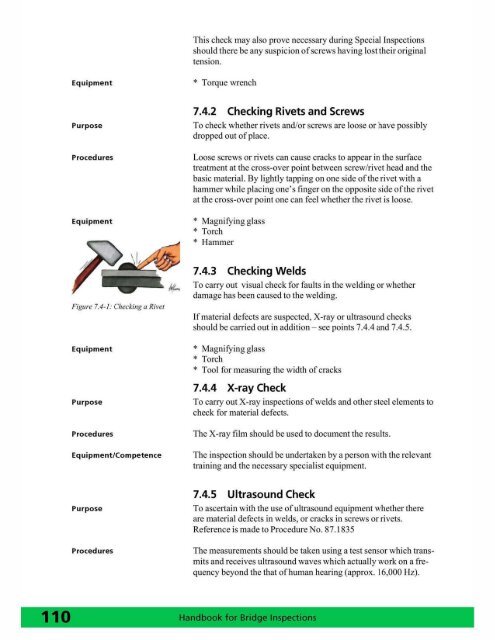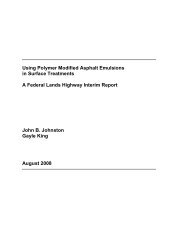Handbook for Bridge Inspections - TSP2
Handbook for Bridge Inspections - TSP2
Handbook for Bridge Inspections - TSP2
Create successful ePaper yourself
Turn your PDF publications into a flip-book with our unique Google optimized e-Paper software.
This check may also prove necessary during Special <strong>Inspections</strong><br />
should there be any suspicion of screws having lost theirorigina l<br />
tension.<br />
Equipment<br />
• Torque wrench<br />
Purpose<br />
Procedures<br />
Equipment<br />
7.4.2 Checking Rivets and Screws<br />
To check whether rivets and/or screws are loose or have possibly<br />
dropped out of place.<br />
Loose screws or ri vets can cause cracks to appear in the surface<br />
treatment at the cross-over point between screw/rivet head and the<br />
basic material. By lightl y tapping on one side oflherivet wi th a<br />
hammer whi le placing one's finger on the opposite side of the ri vet<br />
at the cross-over point one can feel whether the ri vet is loose.<br />
• Magnifying glass<br />
• Torch<br />
• Hammer<br />
Figure 7.4-/: Checking a RiI'el<br />
Equipment<br />
Purpose<br />
Procedures<br />
Equi pment/Competence<br />
7.4.3 Checking Welds<br />
To carry out visual check <strong>for</strong> fau lts in the welding or whether<br />
damage has been caused to the welding.<br />
If material defects are suspected, X-ray or ultrasound checks<br />
should be carried out in addition - see points 7.4.4 and 7.4.5.<br />
• Magni fy ingglass<br />
• Torch<br />
• Tool <strong>for</strong> measuring the width of cracks<br />
7.4.4 X-ray Check<br />
To carry out X-ray inspections of welds and other steel elements to<br />
check <strong>for</strong> material defects.<br />
The X-ray fi lm should be used to document the results.<br />
The inspection should be undertaken by a pe rson with the relevant<br />
training and the necessary speciali st equipment.<br />
Purpose<br />
Procedures<br />
7.4.5 Ultrasound Check<br />
To ascertain with the use of ultrasound equipment whether there<br />
are material defects in welds, or cracks in screws or ri vets.<br />
Reference is made to Procedure No. 87. 1835<br />
The measurements should be taken using a test sensor whi ch transmits<br />
and receives ultrasound waves which actually work on a frequency<br />
beyond the that of human hearing (approx. 16,000 Hz).
















